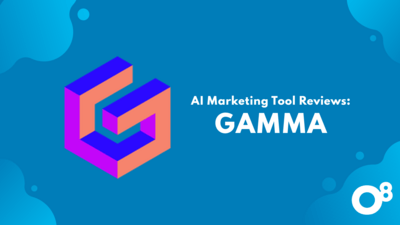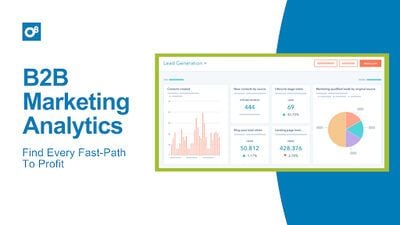B2B Content Marketing Strategies: How to Engage and Convert Your Audience

- Summary
- Why You Need a B2B Content Marketing Strategy
- Steps to Create a B2B Content Marketing Strategy
- Content Distribution and Promotion Channels
- Measuring the Effectiveness of Your Strategy
- Coming Up with Content Ideas
- Using HubSpot to Boost Your B2B Inbound Marketing Strategy
- Creating Great Content for B2B Marketing
- Conclusion
In the fast-paced world of B2B marketing, creating content that truly resonates with your audience can feel like an uphill battle. You spend countless hours crafting blog posts, white papers, and social media posts, only to see minimal engagement and lackluster results. Sound familiar?

The core issue often lies in the absence of a cohesive, data-driven content marketing strategy. Without a well-defined roadmap, your efforts can become disjointed, leading to several challenges:
- Identifying and addressing your target audience's specific needs.
- Ensuring consistent and effective content distribution.
- Accurately tracking and measuring the impact of your content.
- Allocating limited resources efficiently.
- Maintaining a unified message and strategy across all content channels.
But don't worry—there's a solution. By implementing a structured B2B content marketing strategy, you can turn chaos into clarity and drive measurable growth for your marketing and sales teams. In this blog post, we'll guide you through the steps to build a robust strategy that engages your audience and boosts your bottom line.
Why You Need a B2B Content Marketing Strategy
In the B2B landscape, content marketing isn't just a buzzword—it's a crucial tool for driving business success. A well-crafted content strategy can significantly enhance your brand awareness, generate high-quality leads, and improve customer engagement. But why is it so vital for B2B companies?
First and foremost, B2B buyers are different from B2C consumers. They typically embark on longer and more complex buyer journeys, requiring extensive research and multiple touchpoints before making a decision. High-quality content can guide them through this journey, building trust and positioning your company as a thought leader in your industry.
Moreover, a strategic approach to content marketing helps you:
- Align with Buyer Personas: By understanding who your target audience is, you can tailor your content to meet their specific needs and pain points.
- Boost SEO and Organic Traffic: Quality content that's optimized for search engines can drive organic traffic to your website, enhancing your visibility and reach.
- Nurture Leads: Engaging content keeps prospects interested, moving them through the sales funnel and closer to conversion.
- Demonstrate Value: Thoughtful content showcases your expertise and provides valuable insights that can help your audience solve their problems.
With these benefits in mind, let's dive into the steps to create a successful B2B content marketing strategy.
Steps to Create a B2B Content Marketing Strategy
Creating a successful B2B content marketing strategy requires a structured approach. Here are the steps to ensure your strategy is effective and aligns with your business goals:
1. Define Your Goals and Objectives

Before diving into content creation, it's essential to establish clear goals. What do you want to achieve with your content marketing efforts? Common objectives include increasing brand awareness, generating leads, boosting website traffic, and nurturing existing clients.
2. Understand Your Target Audience

Your content needs to speak directly to the needs and pain points of your audience. Develop detailed buyer personas to understand their demographics, challenges, and preferences. This will help tailor your content to resonate with your target audience. One effective tool to aid in this process is a Message House. A Message House helps you organize clear and consistent messages that resonate with your audience by aligning your content strategy with your core messaging framework.
3. Perform a Content Audit
Assess your existing content to identify what’s working and what’s not. This step involves analyzing the performance of your current content to find gaps and opportunities for improvement. Tools like Google Analytics can be invaluable in this process.
4. Develop Content Themes and Topics
Based on your goals and audience insights, brainstorm content themes that align with your business objectives and SEO goals. Consider industry trends, common pain points, and keyword research to generate topic ideas. Aim for a mix of content types such as blogs, white papers, videos, and webinars. Tools like AnswerThePublic and SEMrush can help you identify trending topics and perform keyword research.
5. Create a Content Calendar

A content calendar helps you plan and organize your content production and distribution. It ensures consistency and allows you to align your content with key events, product launches, and marketing campaigns. Use tools like Trello or Asana to manage your content calendar efficiently.
By following these steps, you'll be well on your way to developing a comprehensive B2B content marketing strategy that drives measurable results. Next, let's explore how you can effectively distribute and promote your content to maximize its impact.
Content Distribution and Promotion Channels
Creating high-quality content is only half the battle. To ensure your content reaches your target audience, you need an effective distribution and promotion strategy. Here are some key channels and methods to consider:
Social Media
Leverage social media platforms such as LinkedIn, Twitter, and Facebook to amplify your content. Social media not only helps in increasing brand awareness but also in generating leads. Share your content regularly and engage with your audience to build relationships and drive traffic back to your website. Utilize different types of content like infographics, videos, and case studies to capture the attention of decision-makers.
Email Marketing
Email remains one of the most effective channels for content distribution. Use your email list to share valuable content, promote new blog posts, and nurture leads through targeted email marketing campaigns. Tools like Mailchimp and HubSpot can help you manage and automate your email marketing efforts. Email newsletters can include various content formats such as white papers, webinars, and video content to keep your audience engaged.
SEO and Organic Search
Optimizing your content for search engines can drive organic traffic to your website. Focus on relevant keywords, create long-form content, and use meta descriptions and alt tags to enhance your SEO. Tools such as Yoast SEO and Google Search Console can help you optimize your content for better search engine rankings. Monitoring your content marketing efforts through SEO helps in understanding what works and what doesn’t.
Paid Media
Investing in paid media, such as PPC (Pay-Per-Click) advertisements on Google Ads or sponsored posts on LinkedIn, can help you target specific audiences and boost the visibility of your content. Platforms like Google Ads and LinkedIn Ads offer advanced targeting options to ensure your content reaches the right people. Paid media can enhance your content distribution strategy by focusing on specific demographic and buyer personas.
Content Repurposing
Maximize the value of your content by repurposing it across different formats and social media platforms. Turn blog posts into infographics, webinars into podcasts, and white papers into eBooks. This not only extends the lifespan of your content but also helps you reach different segments of your audience. Repurposing content helps in building thought leadership and ensures that your high-quality content reaches a broader audience.
Influencer Marketing
Collaborate with industry influencers to expand your reach and credibility. Influencers can help promote your content to their followers, providing social proof and increasing your content’s visibility. Tools like BuzzSumo can help you identify and connect with relevant influencers in your industry. This strategy can significantly improve your brand awareness and content distribution efforts.
By utilizing these distribution and promotion channels, you can ensure that your content reaches a wider audience and drives meaningful engagement. Effective content distribution is vital for your overall digital marketing strategy, helping you to achieve better rankings and build trust with potential customers.
Measuring the Effectiveness of Your Strategy
Tracking the performance of your B2B content marketing strategy is crucial for understanding what works and what needs improvement. Here are some key metrics and tools to help you measure the effectiveness of your strategy:

Engagement Metrics
Engagement metrics provide insights into how your audience interacts with your content. Key engagement metrics to track include:
- Page Views: The number of times a page is viewed.
- Average Time on Page: The average amount of time visitors spend on a page.
- Bounce Rate: The percentage of visitors who leave your site after viewing only one page.
- Social Shares: The number of times your content is shared on social media platforms.
Conversion Metrics
Conversion metrics help you understand how well your content is driving leads and sales. Important conversion metrics include:
- Lead Generation: The number of leads generated from your content, tracked through forms, downloads, and sign-ups.
- Conversion Rate: The percentage of visitors who take a desired action, such as filling out a form or making a purchase.
- Cost Per Lead (CPL): The amount of money spent to acquire each lead.
SEO Metrics
SEO metrics help you gauge the effectiveness of your content in driving organic traffic. Key SEO metrics to monitor include:
- Organic Traffic: The number of visitors arriving at your site from search engines.
- Keyword Rankings: The position of your content in search engine results for target keywords.
- Backlinks: The number and quality of external sites linking to your content.
Tools for Measurement
Several tools can help you track and measure the effectiveness of your content marketing strategy:
- Google Analytics: For tracking engagement metrics and conversion rates. Google Analytics
- HubSpot: For lead generation and marketing automation. HubSpot
- SEMrush: For keyword rankings and SEO analysis. SEMrush
- Moz: For tracking backlinks and SEO performance. Moz
By regularly monitoring and analyzing these metrics, you can gain valuable insights into the performance of your B2B content marketing strategy and make data-driven decisions to optimize your efforts.
Coming Up with Content Ideas
Generating fresh and engaging content ideas is essential for a successful B2B content strategy. Your content should align with your audience's needs and your business objectives, guiding your prospects through the various stages of the buyer's journey. Here’s how to consistently come up with great content ideas that resonate with your audience:
Understanding Your Audience
To create successful content, you need to understand your audience's pain points, preferences, and decision-making processes. This involves thorough research and the use of tools like CRM systems to gather insights on your target audience.
Brainstorming Content Ideas
- Conduct Keyword Research Utilize tools like Google Keyword Planner and SEMrush to discover relevant keywords that can inspire new content. Focus on keywords that align with your B2B content strategy and address specific stages of the buyer's journey.
- Analyze Competitors Look at what your competitors are doing to gather ideas. Use tools like BuzzSumo to see which pieces of content are performing well in your industry. This can provide insight into what resonates with your audience.
- Survey Your Audience Directly ask your audience what they want to see. Use surveys or social media polls to gather their preferences and pain points, which can lead to content ideas that are sure to engage them.
- Leverage Industry Reports Resources like the Content Marketing Institute offer industry reports and trend analyses that can spark new content ideas. These reports often highlight successful content strategies and emerging trends in B2B content marketing.
Creating a Content Calendar
Once you have a list of content ideas, organize them into a content calendar. This helps you plan and distribute your content effectively, ensuring consistency and alignment with key business events and campaigns. Use templates available in tools like Trello or Asana to streamline this process.

Types of Content to Consider
- Blog Posts: Great for answering common questions and providing in-depth insights.
- White Papers and Ebooks: Ideal for detailed guides and thought leadership pieces.
- Videos and Webinars: Effective for demos and visual storytelling.
- Infographics: Perfect for summarizing complex information and making data digestible.
- Case Studies: Showcase your successful content and provide social proof.
By consistently coming up with new content ideas and carefully planning their execution, your B2B content strategy will stay fresh, engaging, and effective. This approach will help you build trust, drive engagement, and ultimately lead to successful content marketing outcomes.
Maximize Your Content’s Reach and Impact
Discover how O8’s holistic content distribution strategies can help you reach a wider audience and achieve your marketing goals
Using HubSpot to Boost Your B2B Inbound Marketing Strategy

Leveraging the power of HubSpot can revolutionize your B2B content marketing strategy by centralizing your inbound marketing efforts. Inbound marketing focuses on attracting, engaging, and delighting your target audience through valuable and relevant content. Here’s how HubSpot can enhance your strategy and help you achieve your marketing goals.
Centralizing Content Creation and Management
HubSpot provides a robust platform for content creation and management, enabling you to produce and organize great content in various formats such as blog posts, white papers, and case studies. With HubSpot’s content management system (CMS), you can seamlessly create new content that aligns with your brand awareness goals and speaks to your target demographic.
Enhancing Email Marketing Campaigns
Email marketing is a crucial component of any B2B content marketing strategy. HubSpot’s email marketing tools allow you to create engaging content that can be personalized based on your audience's preferences and behaviors. By integrating automated workflows, you can nurture leads through targeted email campaigns, ultimately driving conversions and improving your rankings in search engine results.
Boosting Lead Generation and Conversion Rates
HubSpot offers comprehensive tools for lead generation, including form builders, landing pages, and call-to-action (CTA) buttons. These tools help you capture valuable information from potential customers and guide them through the buyer’s journey. By leveraging HubSpot, you can track and measure the success of your inbound marketing efforts, ensuring that each piece of content contributes to your overall marketing objectives.
Utilizing SEO and Analytics for Better Insights
HubSpot’s SEO and analytics features provide in-depth insights into your content’s performance. By using these tools, you can discover which keywords and topics resonate most with your audience, allowing you to create highly targeted content that enhances your brand awareness. Monitoring your content’s impact on organic traffic and conversions helps you adjust your strategy for continuous improvement.
Thought Leadership and Brand Authority
One of the key benefits of using HubSpot for your inbound marketing efforts is the ability to establish thought leadership within your industry. By consistently publishing high-quality content and engaging with your audience, you position your business as a trusted thought leader. This not only improves your brand’s credibility but also attracts more potential customers who are looking for expertise and reliable solutions.
HubSpot Integrations for Comprehensive Marketing
HubSpot offers numerous integrations with other tools and platforms, enhancing your overall marketing strategy. Whether you’re in the SaaS industry or any other B2B sector, integrating HubSpot with CRM systems, social media platforms, and analytics tools can streamline your marketing efforts and provide a more holistic view of your performance.
By incorporating HubSpot into your inbound marketing strategy, you can create more engaging and effective B2B content that drives brand awareness, generates leads, and boosts conversions. Explore HubSpot today to discover how it can transform your content marketing efforts and help you achieve your business goals.
Creating Great Content for B2B Marketing
Creating great content is essential for any successful B2B content marketing strategy. The goal is to produce high-quality, engaging content that addresses the needs and pain points of your target audience, while also positioning your brand as a thought leader in your industry. Here’s what it takes to create great content for B2B marketing:
Understanding Your Audience
The foundation of great content starts with a deep understanding of your target audience. Who are your decision-makers? What challenges do they face? What kind of content do they find valuable? Developing detailed buyer personas can help you answer these questions and tailor your content to meet their specific needs.
Focusing on High-Quality Content Creation
High-quality content is informative, engaging, and relevant. Whether you’re producing blog posts, white papers, case studies, or videos, ensure that every piece of content is well-researched, well-written, and provides actionable insights. Use data and statistics to support your claims and make your content more credible.
Leveraging SEO Best Practices
Incorporating SEO best practices into your content creation process is crucial for driving organic traffic. Perform keyword research to identify relevant terms your audience is searching for, and integrate these keywords naturally into your content. Use tools like Yoast SEO to optimize your content for search engines.
Utilizing Various Content Formats
Different audiences prefer different types of content. To maximize your reach and engagement, diversify your content formats. This can include long-form blog posts, in-depth white papers, engaging webinars, comprehensive case studies, and visually appealing infographics. Each format serves a unique purpose and can be used at different stages of the buyer’s journey.
Thought Leadership Content
Thought leadership content is a powerful way to establish your brand as an authority in your industry. This type of content demonstrates your expertise and provides valuable insights that help your audience solve their problems. Examples of thought leadership content include:
- In-depth Articles: Long-form content that explores industry trends, challenges, and solutions.
- Research Reports: Original research and data that offer new perspectives and inform your audience.
- Expert Interviews: Conversations with industry leaders that provide unique insights and advice.
- Webinars and Podcasts: Live or recorded sessions that delve into complex topics and offer interactive learning experiences.
Consistency and Regular Updates
Consistency is key to maintaining audience engagement. Regularly update your content to reflect the latest industry trends and insights. This not only keeps your content relevant but also signals to search engines that your site is active, improving your SEO rankings.
Measuring Content Success
Finally, it’s essential to measure the success of your content to understand what works and what doesn’t. Track key performance indicators (KPIs) such as engagement rates, lead generation, conversions, and social shares. Use tools like Google Analytics and HubSpot to gather data and gain insights into your content’s performance.
By focusing on high-quality content creation, leveraging SEO best practices, and consistently producing valuable thought leadership content, you can create great content that engages your audience, builds trust, and drives business results. Great content is the cornerstone of any successful B2B content marketing strategy, helping you achieve your marketing objectives and establish your brand as a trusted authority in your industry.
Ready to Transform Your Content Marketing Strategy?
Schedule a free consultation with O8 to discover how our expert team can help you create high-quality, engaging content that drives results.
Conclusion
Creating a successful B2B content marketing strategy involves a meticulous approach to understanding your audience, generating high-quality content, and effectively distributing it across various channels. Here are the key takeaways:
- Understand Your Audience: Develop detailed buyer personas to tailor your content to the specific needs and pain points of your target audience.
- Focus on High-Quality Content Creation: Ensure every piece of content is well-researched, well-written, and adds value to your audience. Utilize data and statistics to enhance credibility.
- Leverage SEO Best Practices: Perform keyword research and optimize your content for search engines to drive organic traffic.
- Utilize Various Content Formats: Diversify your content to include blog posts, white papers, videos, infographics, and case studies to cater to different preferences.
- Thought Leadership Content: Establish your brand as an industry authority by producing in-depth articles, research reports, expert interviews, and engaging webinars.
- Consistency and Regular Updates: Maintain a consistent publishing schedule and regularly update your content to keep it relevant and engaging.
- Measure Content Success: Track key performance indicators (KPIs) to understand the effectiveness of your content and refine your strategy accordingly.
By implementing these strategies, you can create compelling content that not only resonates with your audience but also positions your brand as a thought leader in your industry. Remember, the goal is to provide valuable, relevant, and engaging content that guides your prospects through the buyer’s journey and drives measurable growth for your business.
Now that you’re equipped with the knowledge to enhance your B2B content marketing strategy, why not take the next step? Contact O8 for a free consultation to see how we can help you achieve your marketing goals. Let’s work together to create a content strategy that delivers results.







